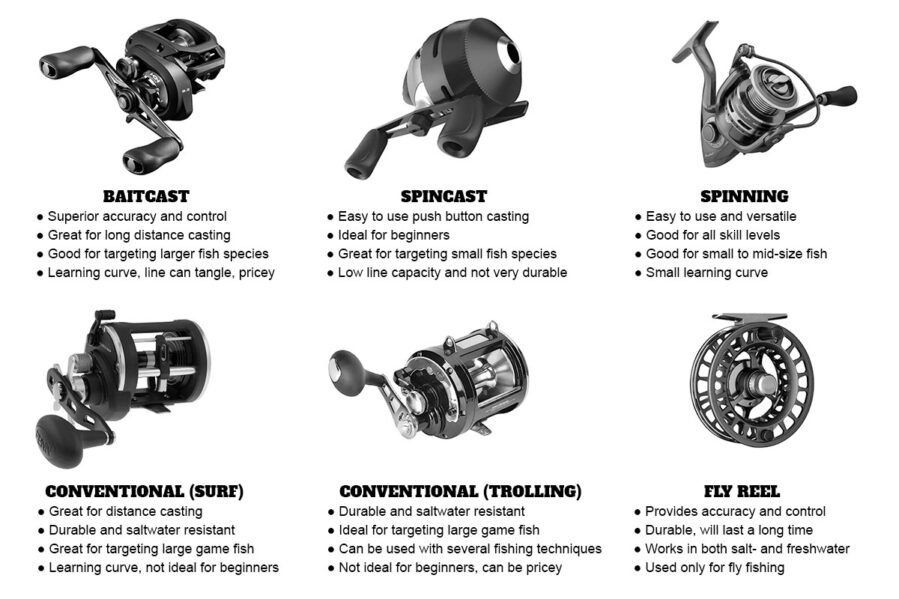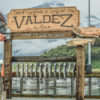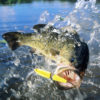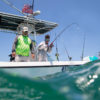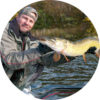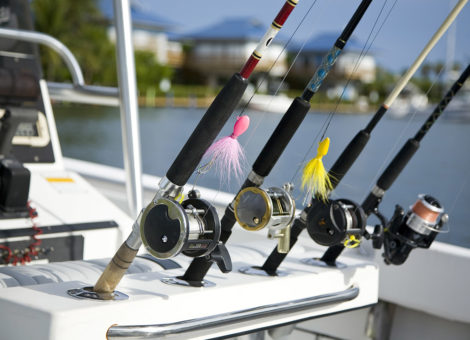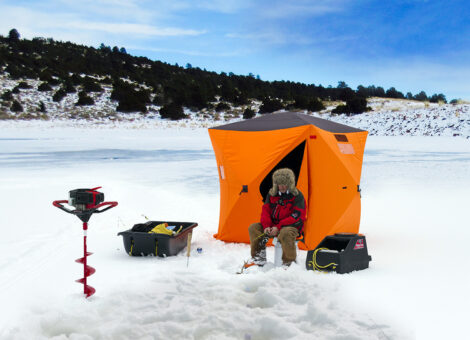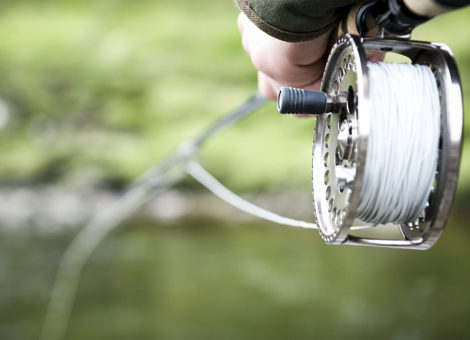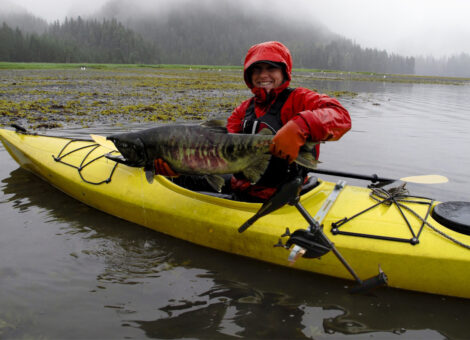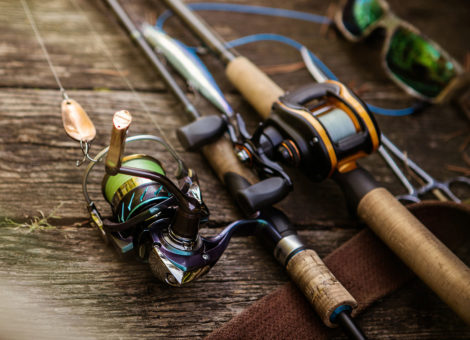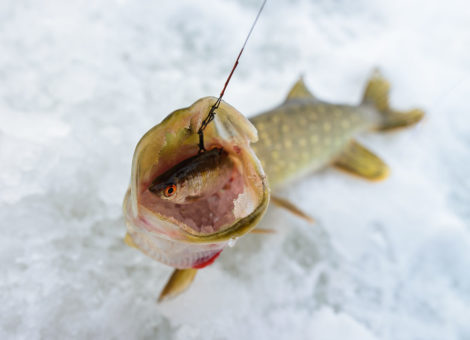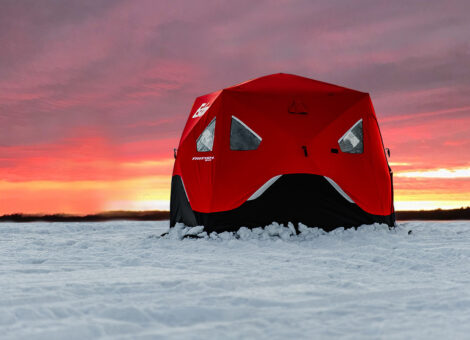There are five main types of fishing reels: spincast, spinning, baitcast, fly and conventional. However, if you break conventional reels into surf casting reels and trolling reels, there are really six reel types to consider. Although their general function is the same, each reel has specific features that make it more effective depending on the fishing situation and your level of experience.
| Reel type | Benefits | Considerations | Where to use | Fishing technique |
|---|---|---|---|---|
| Spincast | Inexpensive, easy to use | Limited range, not very durable | Lakes, ponds | Cast and retrieve Drifting Still fishing Jigging Bottom fishing |
| Spinning | Very versatile, better power, better control | Tangles easily, not best for large lines | Lakes, ponds, rivers, ocean, surf | Cast and retrieve Drifting Still fishing Surf casting Trolling Jigging Bottom fishing |
| Baitcast | Improved accuracy and distance casting | Can tangle, challenging for beginners | Lakes, ponds, ocean, surf | Cast and retrieve Surf casting Jigging |
| Conventional | Versatile, good for larger fish | Not ideal for beginners, heavier, more expensive | Lakes, ocean, surf | Surf casting Trolling Bottom fishing Jigging |
| Fly Fishing | Durable, easy to cast | Only works for fly fishing, relatively expensive | Lakes, ponds, rivers | Fly fishing |
In the following guide, I’ll review all six reel types in detail to help you better understand the pros and cons of each. Armed with this information, you can feel confident you’re choosing the best reel for your next fishing adventure.
Spincast Reel
On a spincast reel the spool is fully enclosed in an oval-shaped casing. Fishing line feeds out of a small hole on the top of the cover. Spincast reels feature a button on the back of the casing that you push in when casting. Simply hold the button down as you cast out your line, then release the button when you want the line to launch.
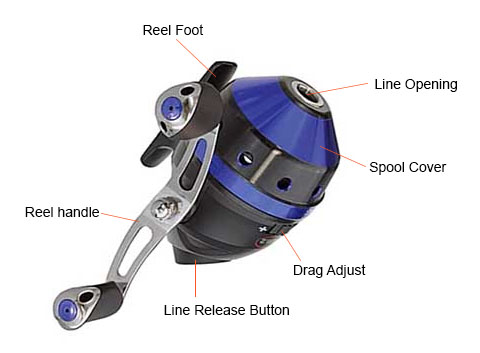
Spincast reels are good a choice for beginners and weekend warriors who don’t want to hassle with learning how to cast more complex reels. There’s nothing complicated about a spincast reel. And if you’re budget conscience, a spincast reel is going to be your most inexpensive option.
A quality spincast reel will have a drag adjustment feature that provides you the ability to adjust the amount of resistance the fish will encounter when it tries to swim away after it’s hooked. The drag adjustment is usually a knob or switch on the side or back of the reel casing.
Advantages
The spincast reel is popular with beginners because:
- It’s easy to cast. Just push the button, aim, pitch, and release.
- It rarely tangle.
- It’s relatively inexpensive.
Disadvantages
The spincast reel may be the easiest to use, but it has a few drawbacks:
- It’s not very durable. Since they’re inexpensive, they’re often cheaply made. Expect to buy a new spincast reel every season or two.
- It can’t cast as far and isn’t as precise as the other reels.
- It’s really only good for targeting smaller fish (perch, bluegill, panfish, small trout, etc.)
Spinning Reel
Spinning reels are popular among both novice and more experienced anglers. They require a bit more skill to master but most beginners can become proficient casting with a spinning reel in just a few hours. Spinning reels are ideal for fishing light to medium baits and lures. They can be used with just about every fishing method from cast and retrieve to surf casting to deep sea fishing.
These reels don’t have an enclosed casing, so the spool of line is visible. This allows the line to move without interference, creating a smooth casting experience. Spinning reels attach underneath the rod and feature a metal bar, called a bail, instead of a button. The bail performs two functions. First, it locks the line after you cast it out. Second, it acts as a guide for the line upon retrieve as it re-enters the spool.
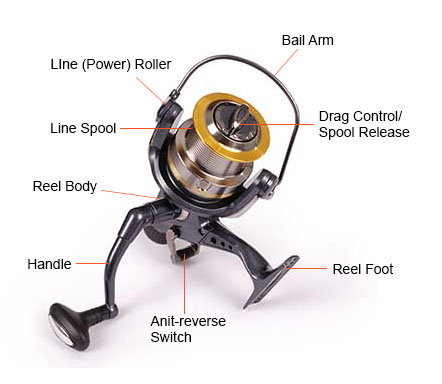
When you’re just getting started with a spinning reel, it can be a bit tricky to handle. You have to be careful when casting, otherwise you’ll end up with the dreaded “bird’s nest”—a line tangle that is nearly impossible to unravel.
To cast with a spinning reel, open the metal bail and use your index finger to hold the line tight to the rod, so it doesn’t unspool. Then, bring your rod back as you normally would, either overhead or to the side. Pitch the rod forward aiming where you want your bait to land. When your rod reaches the 10 o’clock position release the line with your index finger to launch your lure.
Advantages
The spinning reel is popular with anglers for several reasons.
- It’s versatility allows it to be used with many fishing techniques.
- It has a relatively large line capacity.
- It allows for accurate, controlled casts.
- It works well with light or heavier lures.
- It’s is durable. Should last several years.
Disadvantages
As good as it is, a spinning reel does have a few drawbacks.
- It’s a bit more pricey than spincast reels.
- It can tangle easily if don’t have your cast perfected.
- It isn’t ideal for casting heavier line and tackle.
Baitcast Reel
Baitcast reels, also referred to as “baitcasters” or baitcasting reels, are designed to handle heavier line and tackle for targeting larger fish such as black bass and pike. They are excellent for fishing along weed cover and shorelines where accurate, distance casting is a must. Once mastered, most anglers prefer using a baitcaster over a spinning reel—although there is a bit a learning curve.
Unlike spinning reels that are attached under the rod, baitcast reels sit on top perpendicular to the rod. When casting, the entire spool rotates as the line is released, minimizing line twists and tangles compared to a spinning reel. The rotating spool also helps increase casting distance and accuracy, making baitcast reels an attractive option for more experienced anglers who want to up their game.

A baitcast reel looks like a hybrid between a spincast and a spinning reel. The spool of line is only partially enclosed and sits on the top of the rod. Like a spinning reel, the baitcast reel has the ability to adjust the drag. However, it has two additional features: a brake and a spool tension knob. Using these three features, you can really customize your casting. You can be extremely precise in your bait placement once you get the hang of casting with baitcast reel.
Another important difference with the baitcast reel is how you stop the line after you cast it out. Unlike spincast and spinning reels that have mechanisms that help you stop the line, with the baitcast reel, you stop the cast by pressing your thumb against the spool. After your bait lands in the correct spot, you simply press the clip to lock the line in place and retrieve.
If you’re primary fishing method is cast and retrieve, and you want to increase casting distance and accuracy, you may want to give a baitcast reel a try. Just be aware it will take some practice before you’ll be able to use it effectively.
Advantages
A baitcast reel provides anglers the following advantages.
- Ability to achieve maximum distance casting.
- Superior accuracy and control of bait placement.
- The versatility be used in various conditions.
- Target larger, powerful fish species.
Disadvantages
There are a few disadvantages anglers should be aware of before purchasing a baitcast reel.
- A baitcast reel can be challenging to master.
- Brake and spool adjustment must be made to match new lure sizes.
- A baitcast reel is typically more expensive than a spincast or spinning reel.
- A baitcast reel is prone to tangles—especially when you’re first learning how to cast.
There are two types of baitcast reels: round baitcast reels and low-profile baitcast reels. Round baitcast reels have a larger spool with greater line capacity. If achieving maximum distance casting is your objective, this is your best option. Low-profile baitcast reels are lightweight and more ergonomic. They’re ideal for targeting a range of small to medium size gamefish. Line tangle with low-profile reels is minimized.
Conventional/trolling Reel
As opposed to casting, conventional trolling reels are designed to drop and pull line behind a boat. They’re ideal for fishing larger game fish such as sailfish, marlin, and large tuna in the open ocean and coastal waters, or the likes of lake trout and northern pike in large, deep freshwater lakes.
Trolling reels hold a high capacity of heavy test line and have powerful drag systems. Most trolling reels use either a star drag or lever drag. A star drag is set to a specific drag pressure for the duration of a retrieve. With a lever system the angler can adjust drag pressure throughout the retrieve. The lever drag is preferred for tackling larger fish that really put up a fight.
Trolling reels can be either single or dual speed. Big fish anglers typically prefer fishing with a dual-speed reel that can be switched from high-speed retrieve for bringing line in quickly to a low-speed retrieve that provides power for tackling large fish.
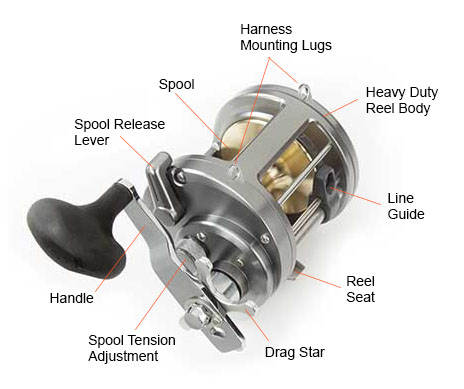
In addition to trolling, a heavy duty conventional reel can also be used for bottom fishing and vertical jigging. A good setup for trolling or bottom fishing is a 7-foot, medium-heavy rod coupled with a 30 pound conventional reel spooled with 50 pound braid and a 100 yard monofilament top shot. For vertical jigging, just remove the topshot.
When selecting a trolling reel, look for something made of machined aluminum or heavy-duty graphite. And if you want to make sure you always know when you have a fish on the line, purchase a reel equipped with a loud counter/clicker that you can hear over the engine of your boat.
Advantages
- Durable and saltwater resistant.
- Ideal for targeting large game fish.
- Can be used with several fishing techniques.
Disadvantages
- Heavier and harder to transport.
- Not ideal for beginner anglers.
- A good conventional reel can be expensive.
Conventional reels come in several styles and options.
- Low-profile reels provide maximum lure control.
- Level-wind reels evenly distribute line on the spool during retrieve.
- Round/open frame reels are best for making long casts (and for surf fishing).
- Single-speed reels have one gear setting and are best for targeting medium size fish.
- Dual-speed reels have a high and low gear setting. The low gear setting provides torque for bringing larger fish.
Surf Casting Reel(s)
There isn’t just one type of reel for surf casting. Each angler has their own preference, but typically anglers will use a spinning reel, baitcast reel, or conventional reel. All three reels are used for surf casting. Which reel type you use ultimately comes down to personal preference.
Spinning reels are great if you want something relatively lightweight and versatile with high retrieval rates. However, if you go with a spinning reel make sure it will hold up to the saltwater and has some degree of waterproofing. A larger spinning reel in the 4500 to 6500 range with provide the strength and line capacity for tackling a variety of saltwater surf species.
Baitcast reels, or baitcasters, are a bit more challenging to master than spinning reels, but they cast farther and offer better accuracy. Where a spinning reel relies on the weight of the lure to pull line off the spool, the rotating spool on a baitcaster aids in propelling line forward during the cast. Baitcast reels use either magnets or centrifugal pads to slow the spool on the cast, reducing the chance of the line backlashes.
A drawback of using baitcast reels for surf fishing is they often don’t stand up well to saltwater environments. The level wind systems on baitcast reels tend to get sand stuck in them and jam. A level wind system is a nice amenity, but not absolutely necessary for surf fishing. If you’re going to use a baitcast reel for surf casting, make sure it’s heavier duty reel—and I’d recommend ditching the level wind.
Some anglers will disagree, but for serious surf anglers nothing compares to a conventional reel. They’re a bit intimidating at first, but my experience has been that once you dial it in your conventional reel will cast farther and more reliably than either a spinning reel or baitcaster.
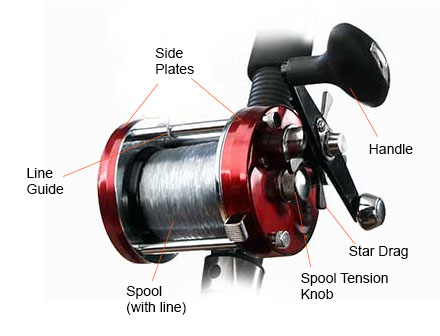
Conventional reels are heavy duty and designed for saltwater fishing. They often have a lower gear ratio compared to baitcast or spinning reels. This means they have a slower retrieve but produce more torque for reeling in larger fish such seabass, halibut, or even shark. A lot of conventional reels come with a dual-speed option which offers both a low gear for power and a high gear for fast line retrieval.
As with a conventional trolling reel, when selecting a conventional reel for surf casting look for something made with graphite, anodized aluminum, or a combination of both. You’ll also want to make sure the drag system and stainless steel ball bearings on the reel are sealed.
Several models of conventional reels can be used for both surf casting and trolling. However, when you’re deepwater trolling you want a conventional reel with heavy duty casing and solid components. Conventional trolling reels often have a high and low gear option for producing additional torque when needed. You can get away with single highspeed gear ratio option in a surf casting reel.
You’ll also note from the above diagrams the conventional trolling reel has harness mounting lugs that are absent on the surf casting reel.
Advantages
- Great for distance casting.
- Can be used with various fishing techniques.
- Ideal for targeting larger fish species.
- Durable and saltwater resistant.
Disadvantages
- Not ideal for beginners.
- Have a learning curve.
Fly Reel
Fly reels cast using the weight of the line rather than the weight of the lure. They use a heavy line that will cast even the lightest fly or lure long distances. A fly reel is very accurate in the hands of a skilled angler and can land a fly in the exact spot where fish are holding.
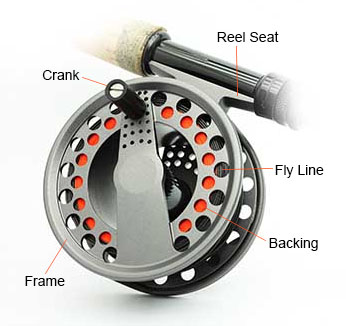
Fly reels are less versatile than spinning or baitcast reels and are used almost exclusively for fly fishing. They have one of two drag systems—disc or click-and-pawl. Disc systems are best for stopping a fish from running and taking out line. Click-and-pawl systems produce minimal drag and are really just good for preventing overspooling.
Fly reels come with one of three retrieval systems—single action, multiplying, or automatic. Single action are the most common type of fly reel. They have a 1:1 retrieve ratio. A full turn of the handle equals one complete rotation of the spool. Multiplying reels have a retrieve ratio greater than 1:1. Automatic reels automatically retrieve line without need for the angler to turn the handle. Single action systems are by far the most reliable. (I would shy away from purchasing an automatic reel.)
A basic fly fishing reel is reliable, simple, and above all, durable. In fact, they’re so durable you can find people fishing with fly reels they purchased over 40 years ago.
Advantages
- Have a high retrieval rate.
- Easy to cast once you get the hang of it.
- Works in both fresh and saltwater.
- Has minimal impact on fish for catch and lease.
Disadvantages
- It’s really only good for fly fishing.
- Relatively more expensive than othere types of reels.
- Requires more practice to pefect technique.
Which Type of Reel Should You Purchase?
You should now have a better idea of which reel style will work best for you. If you’re still unsure, consider your experience level—this should help you decide.
If you’re new to fishing, your best bet is to start with a spincast reel. It’s extremely easy to use—in fact, this is the reel you’ll find on most of the fishing rods made for kids. It is also less prone to tangles, which can ruin a fun fishing experience. When you’re just learning to fish, the last thing you want to do is worry about messing with your reel.
If you’re a bit more advanced and ready to move on to something more complicated, you should try a spinning reel. They’re just slightly more difficult to handle, but once you get used to it, you’ll be able to cast further and with more accuracy. Don’t be intimidated—with a little practice, you’ll be casting like a pro in no time.
Now, if you’ve mastered both the spincast and spinning reel and want to get into some serious fishing, you may want to spring for the baitcast reel. This is the reel to choose if you’re starting to go for bigger sport fish. It’s more powerful and can handle the heavier line you’ll need to bag a trophy fish. Just be aware that all this power and precision doesn’t come easy—it’s going to take some time to get really good at casting with this reel. But if you put in the time and effort, you’ll be able to reap some exciting rewards.
If you’re going to be fishing in saltwater environments, investing in a quality conventional reel for surf casting or deep sea trolling is something I might recommend. Baitcast and spinner reels will get the job done, but a good conventional reel will get the job done just little bit better. I surf fished for years with a spinning reel until I got used to using a conventional reel—and I’ve never looked back.
The great thing about fishing gear is that it doesn’t matter how experienced or inexperienced you are—you can always find something to suit your needs. Make sure you choose a reel that you can handle and that works well with your rod. By making a smart decision, you’ll improve your chances of having an enjoyable fishing experience.


